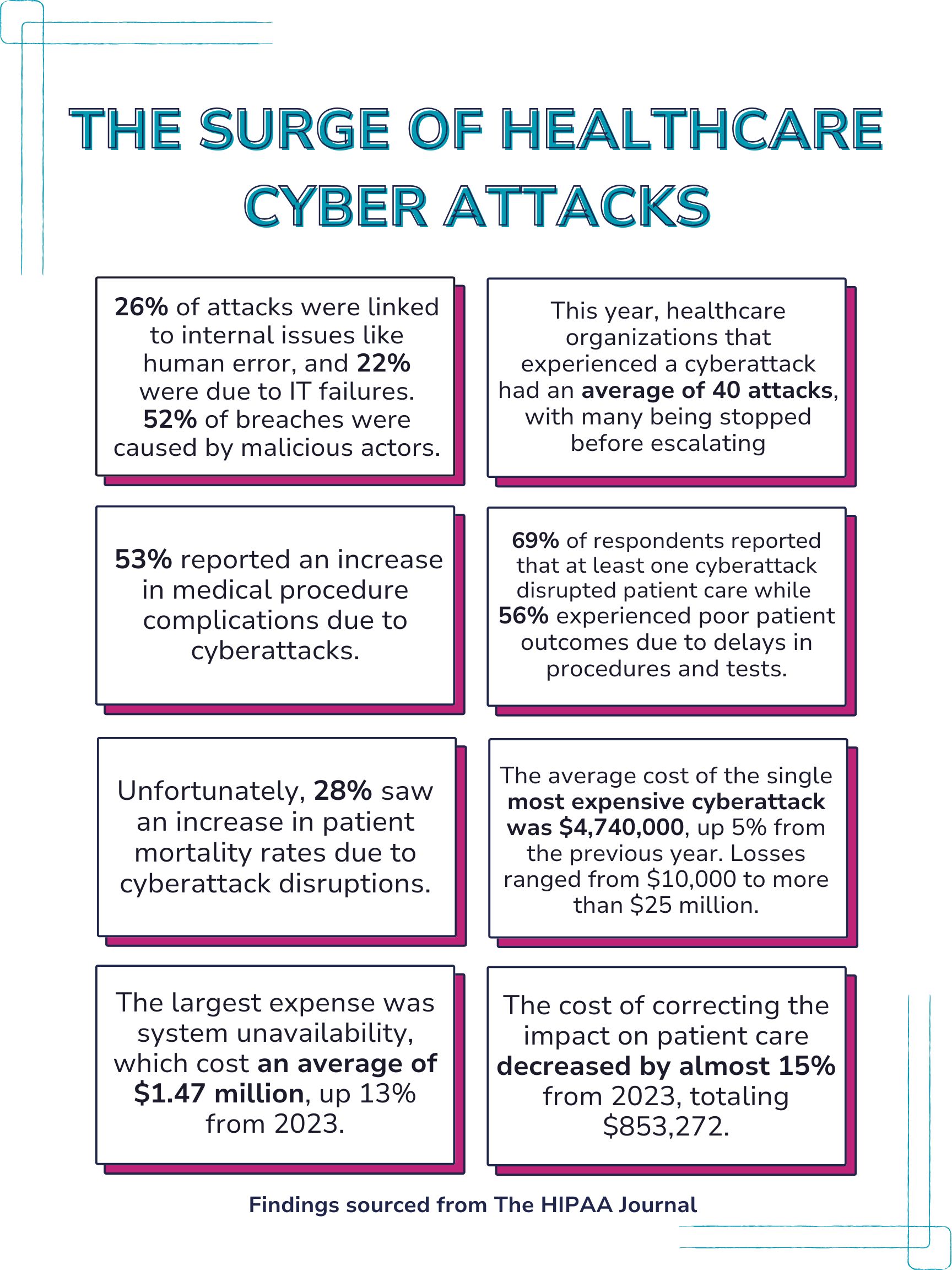For the healthcare sector, the results are a mix of good and bad news. On the positive side, the average cost of a data breach has decreased by 10.6% this year. However, healthcare continues to lead as the most expensive industry for breach recoveries, with an average cost of $9.77 million for the 14th consecutive year.
While there are some signs of improvement, the overall impact of cyberattacks on the healthcare sector remains a serious concern. The following findings highlight the ongoing challenges healthcare organizations face in safeguarding patient care and managing breach-related costs.

In addition to the findings sourced from The HIPAA Journal we discovered:
As healthcare organizations face an increasing number of cyber threats, the landscape is becoming more complex, with both familiar and evolving risks impacting patient care and organizational stability. These risks not only compromise patient data but also disrupt critical operations. Here’s a closer look at the four main threats facing the sector.
Phishing
Phishing remains one of the most widespread cybersecurity threats facing healthcare organizations. This technique involves sending deceptive emails that appear to be from trusted sources, designed to entice users into clicking on malicious links. These emails often reference well-known medical crises, making them particularly convincing. To add an extra layer of deception, some advanced threat actors embed phishing emails within existing email threads, increasing their credibility.
Once a user clicks a malicious link, they are typically directed to a fake website that mimics a login page for internal software. If the user enters their credentials, attackers gain direct access to sensitive healthcare systems.
Ransomware Attacks
While phishing is the most common cyber threat across all industries, ransomware continues to be a major threat to the healthcare sector and contributes significantly to the industry’s high breach recovery costs. The pressure to pay ransoms is amplified by the critical nature of healthcare data, which can directly impact patient care and safety.
Ransomware operators are also escalating their tactics, threatening to report victims to regulatory bodies like the SEC, leading to potential fines. This is especially critical for healthcare, where breaches involving protected health information (PHI) can result in substantial penalties under HIPAA.
HIPAA fines are structured as follows:
Tier One Violation: was unknowable and could not have been avoided with reasonable care. Fine: $130 – $69,000*
Tier Two Violation: should have been known but could not have been avoided even with care. Fine: $1,300 – $69,000*
Tier Three Violation: was proven due to willful neglect, with an attempt to correct. Fine: $13,000 – $69,000*
Tier Four Violation: was proven due to willful neglect, with no correction attempt. Fine: $69,000 – $2,000,000*
* Fine amounts are averages, not exact
Data Breaches
The healthcare sector faces a disproportionate number of data breaches compared to other industries. With HIPAA regulations in place to protect sensitive patient data, many healthcare entities still struggle with implementation gaps that create vulnerabilities. These lapses leave healthcare organizations exposed to breaches that compromise patient information, from medical records to personal identifiers like Social Security numbers.
In many cases, third-party vendors are an overlooked entry point for cybercriminals. Vendors who have access to healthcare data can be a weak link, facilitating indirect access to sensitive information. This is why healthcare providers must not only secure their internal networks but also assess and monitor the security of their third-party vendor relationships.
DDoS Attacks
A Distributed Denial-of-Service (DDoS) attack occurs when attackers flood a server with an overwhelming volume of fake requests, causing the server to go offline. While DDoS attacks do not directly target data exfiltration, they can cause significant disruption to healthcare services, rendering systems temporarily unavailable.
Attackers can leverage botnets—networks of infected devices—to launch these attacks on a large scale. The impact on healthcare organizations can be profound, affecting everything from appointment scheduling to access to critical patient information.
Healthcare organizations are increasingly targeted by a range of cybersecurity threats, meaning safeguarding patient data requires a combination of advanced security technologies and a proactive approach. One effective strategy is penetration testing, which helps identify and address vulnerabilities before they can be exploited by malicious actors.
Depth Security specializes in providing these critical assessments, helping healthcare providers strengthen their defenses and better protect both their systems and patients’ sensitive information. With the right security measures in place, organizations can stay ahead of evolving cyber threats and ensure the continuity of care.